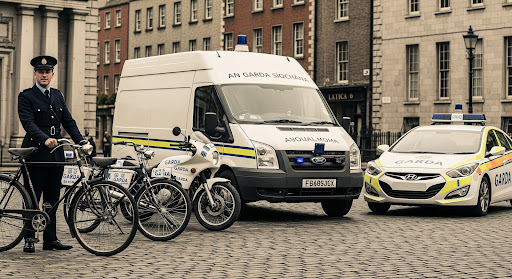When the Civic Guards (later renamed An Garda Síochána) first took to Irish streets in 1922, the sight of officers pedalling through communities on bicycles became an iconic image of the new Irish Free State. Today, as modern Garda patrol cars equipped with the latest technology race to crime scenes, it’s worth reflecting on this remarkable journey of transformation in Garda transportation over the past century.
The Humble Bicycle Era (1922-1940s)
In those early days, bicycles weren’t merely a mode of transport; they represented the accessible, community-focused policing that defined the Garda approach. Guards would cycle through villages and towns, becoming familiar faces to local communities. The bicycle patrol had practical advantages too – they were inexpensive to maintain, required no fuel, and could navigate the often poor road infrastructure of early independent Ireland.
The classic Raleigh bicycle became synonymous with the Garda. These sturdy machines carried officers through all weather conditions, from the rain-soaked western coasts to the urban streets of Dublin. Many older Irish citizens still recall the reassuring sight of the local Garda cycling his beat, cap firmly in place, ready to assist with matters both serious and mundane.
Motorisation Begins (1940s-1960s)
The post-war period saw gradual modernisation as the first motorised Garda vehicles began to appear. Initially, motorcycles complemented the bicycle fleet, offering greater speed and range. The introduction of patrol cars was slow and selective, with vehicles typically assigned to urban stations or specialised units.
By the 1950s, the iconic Ford Anglia and later the Ford Escort became familiar sights as Garda patrol vehicles. These early patrol cars represented a significant investment for the force, but they dramatically improved response times and expanded the operational range of officers.
Interestingly, this period saw a hybrid approach to transport – many rural Gardaí continued to rely primarily on bicycles well into the 1960s, while urban areas saw increasing motorisation. This transition period reflected both budgetary constraints and the practical realities of policing different environments.
The Modern Era (1970s-Present)
The 1970s marked a watershed in Garda transport history. The security challenges presented by the Troubles accelerated the modernisation of the fleet. Purpose-modified patrol vehicles with enhanced capabilities became standard, and specialised units received vehicles appropriate to their functions.
The introduction of the Traffic Corps (now Roads Policing Unit) in 1973 brought high-performance vehicles designed specifically for traffic enforcement. In urban areas, the sight of Garda patrol cars responding to incidents became commonplace, while the traditional bicycle patrol diminished significantly.
Today’s Garda fleet is remarkably diverse, featuring everything from standard patrol vehicles to high-performance interceptors, motorcycles, boats, and even aircraft. Modern Garda vehicles are mobile offices equipped with advanced technology – Automatic Number Plate Recognition (ANPR), mobile data terminals, and sophisticated communication systems that would have seemed like science fiction to the bicycle-mounted Guards of the 1920s.
The Return of the Bicycle?
Interestingly, recent years have seen something of a renaissance for the Garda bicycle. Community policing initiatives in urban areas have reintroduced bicycle patrols, albeit with modern, high-specification mountain bikes rather than the sturdy Raleighs of old. These bicycle units combine the traditional community engagement benefits with modern policing techniques.
Conclusion
The evolution of Garda transport reflects broader changes in Irish society – from the rural, newly-independent nation of the 1920s to the modern European state of today. While technology has transformed how Guards respond to incidents, the fundamental principles remain unchanged: visibility, community engagement, and public service.
Whether pedalling through a village in 1925 or responding in a high-tech patrol car in 2025, the Garda’s mission to serve and protect continues, even as the vehicles that carry them evolve with the times.
Written by Sean Daly Garda

